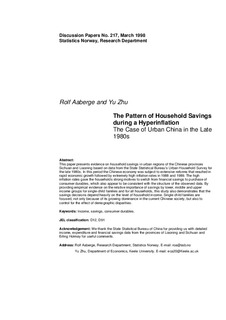| dc.contributor.author | Aaberge, Rolf | |
| dc.contributor.author | Zhu, Yu | |
| dc.date.accessioned | 2012-02-07T22:55:25Z | |
| dc.date.available | 2012-02-07T22:55:25Z | |
| dc.date.issued | 1998 | |
| dc.identifier.issn | 1892-753x | |
| dc.identifier.uri | http://hdl.handle.net/11250/180947 | |
| dc.description.abstract | This paper presents evidence on household savings in urban regions of the Chinese provinces Sichuan and Liaoning based on data from the State Statistical Bureau's Urban Household Survey for the late 1980s. In this period the Chinese economy was subject to extensive reforms that resulted in rapid economic growth followed by extremely high inflation rates in 1988 and 1989. The high inflation rates gave the households strong motives to switch from financial savings to purchase of consumer durables, which also appear to be consistent with the structure of the observed data. By providing empirical evidence on the relative importance of savings by lower, middle and upper income groups for single-child families and for all households, this study also demonstrates that the savings decisions depend heavily on the level of household income. Single-child families are focused, not only because of its growing dominance in the current Chinese society, but also to control for the effect of demographic disparities. | no_NO |
| dc.language.iso | eng | no_NO |
| dc.publisher | Statistics Norway, Research Department | no_NO |
| dc.relation.ispartofseries | Discussion Papers;No. 217 | |
| dc.subject | Income | no_NO |
| dc.subject | Household savings | no_NO |
| dc.subject | China | no_NO |
| dc.subject | Sichuan | no_NO |
| dc.subject | Liaoning | no_NO |
| dc.subject | JEL classification: D12 | no_NO |
| dc.subject | JEL classification: D91 | no_NO |
| dc.subject | consumer durables | no_NO |
| dc.title | The pattern of household savings during a hyperinflation : The case of urban China in the late 1980s | no_NO |
| dc.type | Working paper | no_NO |
| dc.subject.nsi | VDP::Social science: 200::Economics: 210::Economics: 212 | no_NO |
| dc.source.pagenumber | 28 s. | no_NO |
